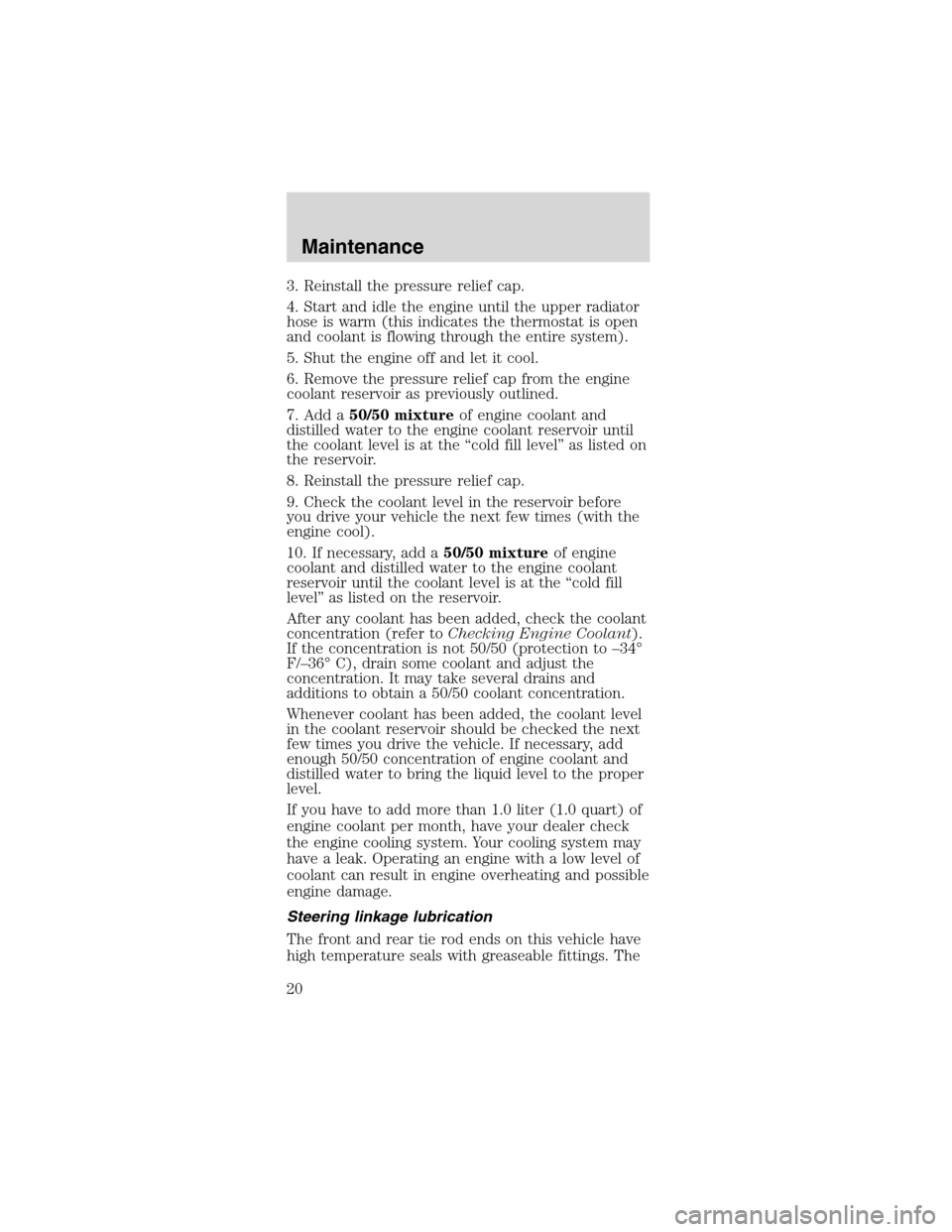Page 20 of 32

3. Reinstall the pressure relief cap.
4. Start and idle the engine until the upper radiator
hose is warm (this indicates the thermostat is open
and coolant is flowing through the entire system).
5. Shut the engine off and let it cool.
6. Remove the pressure relief cap from the engine
coolant reservoir as previously outlined.
7. Add a50/50 mixtureof engine coolant and
distilled water to the engine coolant reservoir until
the coolant level is at the“cold fill level”as listed on
the reservoir.
8. Reinstall the pressure relief cap.
9. Check the coolant level in the reservoir before
you drive your vehicle the next few times (with the
engine cool).
10. If necessary, add a50/50 mixtureof engine
coolant and distilled water to the engine coolant
reservoir until the coolant level is at the“cold fill
level”as listed on the reservoir.
After any coolant has been added, check the coolant
concentration (refer toChecking Engine Coolant).
If the concentration is not 50/50 (protection to–34°
F/–36°C), drain some coolant and adjust the
concentration. It may take several drains and
additions to obtain a 50/50 coolant concentration.
Whenever coolant has been added, the coolant level
in the coolant reservoir should be checked the next
few times you drive the vehicle. If necessary, add
enough 50/50 concentration of engine coolant and
distilled water to bring the liquid level to the proper
level.
If you have to add more than 1.0 liter (1.0 quart) of
engine coolant per month, have your dealer check
the engine cooling system. Your cooling system may
have a leak. Operating an engine with a low level of
coolant can result in engine overheating and possible
engine damage.
Steering linkage lubrication
The front and rear tie rod ends on this vehicle have
high temperature seals with greaseable fittings. The
Maintenance
20
Page 21 of 32
fittings must be lubricated at regular maintenance
intervals as indicated in the Scheduled Maintenance
Guide using Ford recommended ESA M1C 92A
grease to ensure proper function and extended
service life.
•location of the front
tie rod
•location of the rear tie
rod
USING THE RIGHT BULBS
Function Trade Number
Luggage compartment lamp S211
High-mount brake lamp (Service as
complete assembly)See your Dealer
Fog lamp 9145
WINTER DRIVING
For winter driving, it is recommended to install
radial winter tires.
Winter tires are designed to improve traction in
adverse winter weather conditions.
Note:Use of tire cable/chains are restricted on this
vehicle due to the potential damage to body and/or
suspension components.
Maintenance
21
Page 22 of 32

When installing winter tires:
•Only radial ply winter tires may be installed.
•For a recommended wheel and tire package, ask
your SVT dealer or call the SVT Info. Center at
(800) FORD-SVT.
•Winter tires of the same size and type must be
mounted on all four wheel positions.
•Winter tires must have the same load capacity as
the vehicle’s original equipment tires.
Do not exceed 75 miles per hour in a
vehicle equipped with winter tires.
Winter tires available for your vehicle will
likely have a maximum speed rating which is
less than the maximum speed of your vehicle.
Driving faster than the maximum speed for which
tires are rated and approved may lead to sudden
tire failure. This can cause loss of vehicle control
and lead to an accident and personal injury.
Adjust your driving and speed to prevailing
road and traffic conditions.
Observe the specified tire inflation
pressures.
Have the wheel and tire assemblies balanced
every time the tires are dismounted.
The use of snow cables or chains on the
vehicle (vehicle specific tire size) tire is not
recommended for this vehicle, as damage to your
vehicle may occur.
Maintenance
22